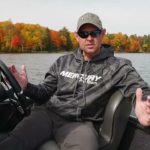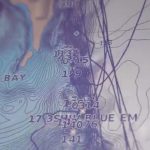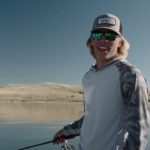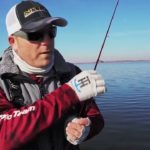Sampling Walleye Success
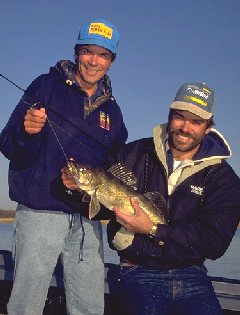 It’s a tough thing to admit, but once in a while we get talked in to trudging ourselves off to the grocery store to do the family shopping. While it ranks as one of our least favorite activities, there are times when it has its good points … like when it’s “sample day”. You know … the day when vendors have their little tables set up in the isle, and offer samples to you as you pass by. Some samples are easy to pass by … either they look like they taste bad, smell bad, or they look like something you’ve already tried and did not like. Others however, draw you in with their appealing aroma, or their delectable look … a “must taste” tidbit. And admit it … at one time or another, you’ve taken a tasty looking sample, sampled it, and smiled as you walked away, only to spit it into a napkin and toss it at the first opportunity … Yuk! There’s a fishing lesson learned! That’s sort of the way river walleyes eat … they’re “samplers”. They live in a world where their meals pass by in the blink of an eye, and force them to make quick decisions as to whether or not they are going to eat the drifting meal. Only difference is, they are masters at rejecting a sample they don’t like, and they don’t use napkins.
It’s a tough thing to admit, but once in a while we get talked in to trudging ourselves off to the grocery store to do the family shopping. While it ranks as one of our least favorite activities, there are times when it has its good points … like when it’s “sample day”. You know … the day when vendors have their little tables set up in the isle, and offer samples to you as you pass by. Some samples are easy to pass by … either they look like they taste bad, smell bad, or they look like something you’ve already tried and did not like. Others however, draw you in with their appealing aroma, or their delectable look … a “must taste” tidbit. And admit it … at one time or another, you’ve taken a tasty looking sample, sampled it, and smiled as you walked away, only to spit it into a napkin and toss it at the first opportunity … Yuk! There’s a fishing lesson learned! That’s sort of the way river walleyes eat … they’re “samplers”. They live in a world where their meals pass by in the blink of an eye, and force them to make quick decisions as to whether or not they are going to eat the drifting meal. Only difference is, they are masters at rejecting a sample they don’t like, and they don’t use napkins.
Knowing this about the eating habits of river walleyes can play a key role in making you a better river angler … or at least it will give you something to think about next time you get roped into doing the grocery shopping. Knowing this gives you three important facts to improve your river walleye fishing … 1, put the bait where the fish is going to see it (location, location, location) … 2, make it appealing enough that the walleye will “sample” it (presenation, presenation, presenation) … and 3, sense the bite quickly and set the hook before the fish has a chance to spit your offering (fun, fun, fun!).
River walleye location is a very predictable thing. Current breaks are key … obstructions such as rock jetties, sand bars, bridges or the lip of a wash-out hole … anything that causes a diversion in current creates a potential holding area for fish. They’ll sit just out of the current, facing into it, watching for a potential meal to come drifting by. It’s important to find the edges of current breaks and present a bait so it will be viewed by the greatest number of likely biters. Lure type and presentation will be determined by the size and type of current break you’re fishing. Most river fishing is done in small, well defined spots that can be fished fairly quickly.
In order to put a lure in front of fish in these spots, vertical jigging is the best way to go. It’s a presentation that requires precise boat control and the right jig/bait combination to trigger bites. The boat control part of the equation comes in keeping the boat moving the same speed as the current while at the same time keeping your jig vertical, or directly below the boat.
 Choosing the right jig and bait is a matter of experimentation. Where ever legal, it’s a good idea to use two rods for vertical jigging. This not only gives you more chances to catch fish, but gives you a perfect way to experiment and fine-tune presentation. For instance, on one rod, rig a plain jig head and minnow combination. Then on the other rod, rig a jig with an attractor like Northland Tackle’s Buck-Shot Rattle and a minnow. If the rattle starts catching more fish, then keep that rod the same and add a little more attraction to the other jig with a Northland Buck-Shot Rattle Spin. The added flash of the spinner may increase the catch rate even more. To add bulk and more color to the presentation, add a Berkley Power Grub to one jig.
Choosing the right jig and bait is a matter of experimentation. Where ever legal, it’s a good idea to use two rods for vertical jigging. This not only gives you more chances to catch fish, but gives you a perfect way to experiment and fine-tune presentation. For instance, on one rod, rig a plain jig head and minnow combination. Then on the other rod, rig a jig with an attractor like Northland Tackle’s Buck-Shot Rattle and a minnow. If the rattle starts catching more fish, then keep that rod the same and add a little more attraction to the other jig with a Northland Buck-Shot Rattle Spin. The added flash of the spinner may increase the catch rate even more. To add bulk and more color to the presentation, add a Berkley Power Grub to one jig.
By contrasting colors of jig heads and bodies, or even using two-tone colored jig heads and bodies, an infinite number of colors can be tried and fine-tuned. Wiring a pattern like this can take some time, but if the absolute best presentation is honed, the results will be well worth the effort.
Of course getting the fish to bite is only half the battle when it comes to catching river walleyes. As stated earlier, these fish are “samplers”, and can reject bait as fast as they can taste it. That means it will take lightning fast reflexes and quick hooksets to get hooks into flesh. Maximizing “feel” is the name of the game in river jig fishing, and that requires sensitive rods and no-stretch line. High modulus graphite rods like the Bass Pro Shops Walleye Angler Signature Series model WX60MLJSH are perfect for fishing under these conditions. With a soft tip section for finesse, and beefy backbone to give it power, this 6 foot, medium light action stick is built from HM-85 (85 million modulus) graphite making it feather-light and yet strong enough to handle any big walleye.
A small diameter, no-stretch line like Berkley’s 6/2 FireLine is the ultimate extension of a good rod’s sensitivity. This is important for achieving the feel it akes to detect subtle bites of sampling walleyes, and then react with an instant hookset. There are good line alternatives, including Berkley Vanish Fluorocarbon, which has low stretch characteristics for sensitivity and is virtually invisible under water, making it perfect for ultra clear water. For anglers that like fishing monofilament, Berkley Sensation is a great choice. It’s strong, lower stretch than conventional mono, and yet is soft and subtle which also makes it a good choice for casting and pitching jigs.
Vertical jigging river walleyes can be a blast! It’s a game of reflexes. When everything falls into place … being in the right location, with the right presentation, and the right equipment … you’ll sample the best walleye fishing has to offer. That beats any sampling you’ll ever get at the grocery store!


